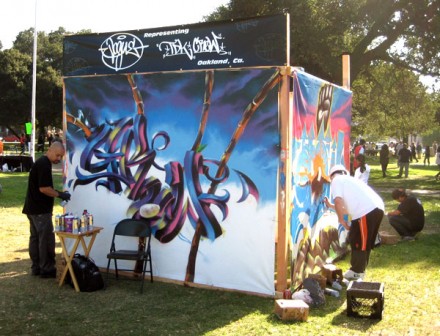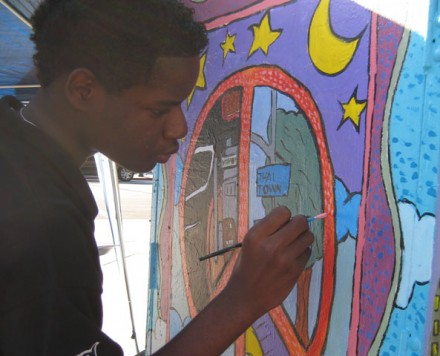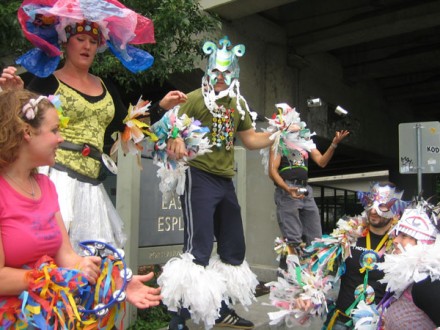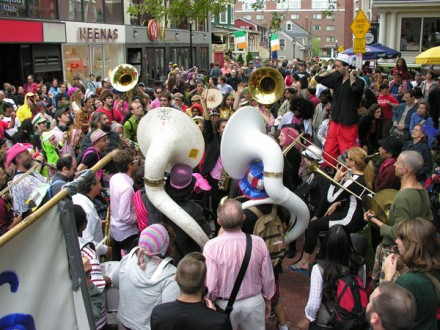Adaptive Architecture

Adaptive Architecture was a community construction project. Collaborating with high school students from Youth Speaks, a non-profit youth radio program in Oakland, California, this project used structural bamboo poles to create modular forms that could be connected and arranged in various configurations, creating dynamic spaces. Built at the Life is Living festival at DeFremery Park in West Oakland, the Adaptive Architecture structures acted as the armature for canvases. Graffiti artists used non-aerosol, non-toxic paint to create environmentally themed tags. Adaptive Architectures were designed to be easily deconstructed, transformed and reconfigured to suit different sites, galleries and events around the Bay Area.
Cardboardia (Cardboard Town Free!)
 Cardboardia ‘towns’ are temporary, collaboratively built and inhabited towns manifesting so far in Moscow, Russia, Finland and Germany. Carboardia is, in essence, a role playing community, where guests can create a new identity while contributing to the growth of the town, using cardboard as their expressive and artistic medium. Every town created under the Cardboardia title is a place where people can reinvent themselves—where, for a short time, everyone can leave behind their daily worries through new ways of self-expression. The Black Rock Arts Foundation’s grant supported the 2009 Cardboardia town built in Moscow, Russia. Cardboardia brings together people of all ages and backgrounds in a conflict free environment. All the participants have equal significance and room for self expression.
Cardboardia ‘towns’ are temporary, collaboratively built and inhabited towns manifesting so far in Moscow, Russia, Finland and Germany. Carboardia is, in essence, a role playing community, where guests can create a new identity while contributing to the growth of the town, using cardboard as their expressive and artistic medium. Every town created under the Cardboardia title is a place where people can reinvent themselves—where, for a short time, everyone can leave behind their daily worries through new ways of self-expression. The Black Rock Arts Foundation’s grant supported the 2009 Cardboardia town built in Moscow, Russia. Cardboardia brings together people of all ages and backgrounds in a conflict free environment. All the participants have equal significance and room for self expression.
East Hollywood Utility Box Art Project

The Utility Box Art Project was a guided collaboration and mentorship program, that paired artists with youth to design and create murals on utility boxes. The team first conducted a neighborhood mapping process in which the artist and youth studied neighborhood issues and gathered input from residents. The youth interviewed a broad range of locals to further their understanding of the community. After a theme was selected, the youth and artist held story-gathering workshops in which community members contributed images, words and ideas to support the development of the final artwork. Each project concluded with a community celebration that coincided with an important local event. The celebration provided the opportunity for the community to gather and support its success, to connect to each other, and to acknowledge the work of the artists (youth and mentors) and community members who created the work. Audience members included visitors from other Los Angeles neighborhoods, who came to experience the final artistic creations.
Escombros Vivos (Live Debris)

Live Debris 2009 (Escombros Vivos) was a traveling series of events and interventions dedicated to sharing and establishing new reuse traditions as a means of reducing stigmas around garbage, poverty and street culture. Starting and ending in Portland, Oregon, a greening city successfully overcoming its stigmas about garbage, Live Debris 2009 traveled to Rio de Janeiro as a bi-lingual, collaborative series of events networking local and international artists to reflect upon humanity’s rapidly changing relationships with our discards. Works of reuse art, craft and design traveled from Portland to Rio de Janeiro, where Brazilian artists physically and philosophically elaborated upon the same works to express their more polemic and necessity-based attitudes towards humanity’s discards. After 5 months of workshops, clothing exchange parties, public interventions and exhibitions, the artwork returned to Portland, Oregon for a series of final events. Live Debris is an annual project which started in 2008 in Beirut, Lebanon. 2009’s project, called Escombros Vivos in Portuguese, worked in collaboration with over 50 artists of diverse backgrounds and disciplines. Live Debris’ current project is in Tokyo, Japan. From fashion designers, graffiti writers, street artisans and activists to clowns, dancers and poets, Live Debris aims to develop lasting relationships between people who are dedicated to reintegrating garbage, public space and marginalized communities.
HONK! Festival

The HONK! Festival is an ongoing, annual festival of activist street bands, as well as a musical and theatrical reclamation of public space. Community participants join 350+ musicians from around the neighborhood and around the world to play, perform, and parade in Davis Square (Somerville, MA) and surrounding underserved neighborhoods of Boston. The 4th annual HONK! Festival that BRAF supported took place on Oct. 9-11 in 2009. Participants of HONK! Festival represent a great diversity of ages, musical backgrounds and abilities and share a commitment to music as a tool for social action. The HONK! Festival serves both to create a cultural exchange between bands and to present the groups’ populist music-making to the public at large. The divisions between performer and audience, public space and private space, and music and non-music are actively challenged.
MicePaceMaze
MicePaceMaze was developed in 2009 as a new, interactive game based on the concept of a mouse maze. The project was essentially a human-sized mouse maze, but with no walls. A camera above a marked off space tracked the motion of the players. The players wore originally designed mouse heads that covered their eyes, and had built-in wireless headphones. Using Max/MSP software, the movements of the players were processed, and the data was turned into audio cues that were heard in the players’ headphones, letting them know if they were maneuvering correctly, or hitting a ‘wall.’ Players were only able to move through a space based on what they heard. The player’s objective was to maneuver through the maze without getting trapped by the hazards of a normal mouse. The maze’s ‘walls’ were represented by the sounds of hissing cats and snapping mousetraps. The less the player heard of these noises, the more points the player earned. If the player was able to maneuver through the maze to the end, they reached the ‘cheese bar,’ after which the computer calculated their score and recorded it. MicePaceMaze was highly accessible and easily customizable to different audiences. The project toured public events, such as Maker Faire.
Pollinator Appreciation Day Community Project
The Pollinator Appreciation Project was a series of workshops, events and collaborative art projects, all geared towards educating the public about the importance of pollinators. Educators and artists hosted workshops, nature walks and talks on various subjects, including butterfly gardens, healing plants and native plants. Other workshops led children and adults in the creation of small sculptures of all sorts of pollinators (butterflies, birds, moths, beetles, bees, and more,) which would later be added to to the Bumblebuzz sculpture, a kinetic, pedal powered showcase for the pollinator sculptures. The sculpture was unveiled as part of the opening of The Rev. Carl Renick Memorial Butterfly Garden.
The Work Office (TWO)
 The Work Office (TWO) is a multidisciplinary art project disguised as an employment agency. The Black Rock Arts Foundation helped fund this project for the year of 2009, however The Work Office is an ongoing piece. Informed by the Works Progress Administration (WPA) of the Great Depression in the 1930s, TWO is a gesture to “make work” for visual and performing artists, writers, and others by giving them simple, idea-based assignments to explore, document, or improve daily life in New York. From a temporary central office, TWO’s administrators Katarina Jerinic and Naomi Miller interview, register, and hire employees; assign, collect, and exhibit work; and distribute Depression-era wages to employees during weekly Payday Parties. Prospective employees submit an application online through the project’s website and, once hired, choose an assignment such as documenting a need for repairs, making a regional travel guide for their block or neighborhood, reinterpreting a newspaper photograph, or giving a concert for a houseplant. Employees have a week to turn in their assignment, for which they are paid $23.50, the weekly wage for an artist in the Federal One Project (the arts division of the WPA).Payday Parties are held at the end of each work week. At these events, employees collect their wages, and the public is invited to view the week’s works and learn about the project. The Payday Parties are inspired by the socializing that occurred between artists as they waited in line to collect their wages at their local WPA office. They also provide a forum for TWO artists and the general public to interact. TWO is based on the idea of “making work” (WPA terminology) for artists to “make work” (artist terminology). With the current economic recession in mind, TWO revisits the approach the 1930s federal government took to alleviate the effects of the Depression on daily life. In the Federal One Project of the Great Depression, artists were seen as a valuable work force and were employed to make art, just as others were hired for projects that rebuilt the country in other ways. TWO is a wry contemporary realization of this model.
The Work Office (TWO) is a multidisciplinary art project disguised as an employment agency. The Black Rock Arts Foundation helped fund this project for the year of 2009, however The Work Office is an ongoing piece. Informed by the Works Progress Administration (WPA) of the Great Depression in the 1930s, TWO is a gesture to “make work” for visual and performing artists, writers, and others by giving them simple, idea-based assignments to explore, document, or improve daily life in New York. From a temporary central office, TWO’s administrators Katarina Jerinic and Naomi Miller interview, register, and hire employees; assign, collect, and exhibit work; and distribute Depression-era wages to employees during weekly Payday Parties. Prospective employees submit an application online through the project’s website and, once hired, choose an assignment such as documenting a need for repairs, making a regional travel guide for their block or neighborhood, reinterpreting a newspaper photograph, or giving a concert for a houseplant. Employees have a week to turn in their assignment, for which they are paid $23.50, the weekly wage for an artist in the Federal One Project (the arts division of the WPA).Payday Parties are held at the end of each work week. At these events, employees collect their wages, and the public is invited to view the week’s works and learn about the project. The Payday Parties are inspired by the socializing that occurred between artists as they waited in line to collect their wages at their local WPA office. They also provide a forum for TWO artists and the general public to interact. TWO is based on the idea of “making work” (WPA terminology) for artists to “make work” (artist terminology). With the current economic recession in mind, TWO revisits the approach the 1930s federal government took to alleviate the effects of the Depression on daily life. In the Federal One Project of the Great Depression, artists were seen as a valuable work force and were employed to make art, just as others were hired for projects that rebuilt the country in other ways. TWO is a wry contemporary realization of this model.

